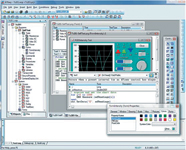

ATEasy is a rapid application development framework and a test executive for functional test, ATE, data acquisition, process control, and instrumentation systems.
A Geotest product, ATEasy provides all the necessary tools to develop and maintain software components, from instrument drivers to complex test programs. It is designed to support and simplify ATE projects with long lifecycles.
ATEasy includes a complete test development suite, which is specifically designed for test applications. The ATEasy development environment combines the ease of use associated with Microsoft's Visual Basic with the flexibility of Microsoft's Visual C++ to create a complete object-oriented, 32-bit Windows programming environment. Users of these programs learn ATEasy quickly, while first time users can use the Application Wizard to generate applications quickly. Application components are displayed in an easy-to-browse tree view that follows the ATEasy framework for test application.
Test executive features
ATEasy comes with a ready-to-run, customisable, test executive module. This provides a user interface for the control and execution of test programs that were created by the test development environment. The user interface allows users to select and run a test program, check or uncheck tests, create and run test sequences, debug tests, and view/print test logs.
The test executive module can be customised to accommodate specific application requirements, which can then be deployed and re-used throughout a test engineering department or organisation. It provides the ability to define user groups as well as customise without programming - the user interface, and options/privileges associated with each user group.
The test executive supports two modes of user interface. The Modal user interface uses a small number of large buttons, which are operated by a touch panel screen, text is entered using the on-screen virtual keyboard or by a mouse/keyboard interface. The Modeless user interface uses the familiar Windows menu bar and toolbar, in conjunction with the mouse and keyboard. The Modal user interface is designed for operators that require a simplified and more directed user interface while the menu driven modeless interface is typically used by more advanced users. Each user interface mode can be assigned to a user group. Additional customisation can be done programmatically using the test executive command library or by changing the test executive source code that is provided with ATEasy.
A test sequence plug-in module allows users to define custom test sequences (profiles). Each profile contains a list of steps that specifies which program, task, or test to run as part of the application as well as specifying the number of times the step should be executed. The profile can also contain conditional actions based on the test status. the profile module is fully integrated with the test executive module and can alternatively be used as a standalone module.
The Test Executive supports automatic generation of HTML and text-based test logs, which can be displayed or saved to a file. Log files can contain all results, failures only or just a summary. Additionally, The Test Executive can be configured to automatically manage the log files - when to backup, when to delete, when to save, how to name. Storing test results to a database and to other file formats is also possible.
ATEasy includes a fault analysis library module that allows the user to build a fault dictionary. Based on the test results and test status, test engineers can define test conditions that when met, can describe the reason for the failure and the necessary action required to repair the UUT. The fault analysis library simplifies the troubleshooting cycle and reduces the time to repair UUTs.
Test development features
ATEasy's test development environment allows test engineers to build test applications from components that are modelled after real-world test systems. These components include a system, drivers, programs, tests, commands, and more. It provides a streamlined, easy-to-follow framework and a wide array of features that enable the user to create these re-usable components. The result is a test application that is faster to generate and easier to maintain.
The application framework consists of well-organised components that allow users to partition and organise their test code during development. When debugging and validating, users can use these components to quickly isolate problems. Once a modification is applied, smaller portions of the application code can be executed independently without running the entire application.
The ATEasy compiler is fast and efficient. During debugging, it compiles only the necessary code as required. Once debugging is complete, it creates an executable file.
Applications can be created using menus or by typing commands directly. With menu commands, users can insert driver commands, procedure calls, and even flow control statements with a few clicks of the mouse. ATEasy's code completion tools provide suggestions on completing the unfinished statements while typing. It also provides tool tips that describe the function call and arguments associated with specific programming parameters.
ATEasy applications are created from a project file that contains the application module files. ATEasy modules are modelled after a test system. Three types of modules are available:
* Program Module - contains the test program (tests).
* System Module - contains the application drivers and their configuration. For example, a GPIB instrument driver configuration may include its primary and secondary address, terminator, etc.
* Driver Module - contains the commands and functions that are required to operate an instrument and the associated hardware interface (eg, GPIB, RS232, etc).
ATEasy is supplied with many popular instrument drivers and all of the currently available standard IVI drivers. In addition, a driver can be created using the ATEasy development environment. ATEasy drivers can also be created by either writing ATEasy procedures, importing VXI P&P and Function Panel files, calling LabView Virtual Instrument drivers, or using external libraries such as DLLs, COM/ActiveX and .NET assemblies.
| Tel: | +27 11 704 6677 |
| Email: | [email protected] |
| www: | www.testandrework.co.za |
| Articles: | More information and articles about Test & Rework Solutions |

© Technews Publishing (Pty) Ltd | All Rights Reserved